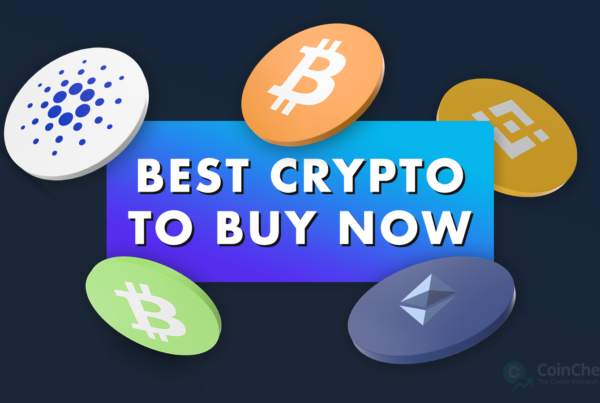At the beginning of Week 22 the total cryptocurrency market capitalization stands at $1.28 trillion – another few $100 billion less than last week. We have seen a lot of development and plenty of announcements last week, therefore we are all hoping for some green numbers this week. Do you think that we will finally see trend reversal or is the crypto market headed even lower – towards the $1 trillion valuation?

3. Chain Protocol (XCN)
Chain is a blockchain technology company that helps build and launch new cryptographic distributed ledgers for various crypto projects and financial institutions. Its main product is the ledger-as-service platform called Sequence. By building new blockchains the company aims to facilitate the creation of a smarter and more interconnected economy. Chain was founded in 2014 and has raised over $40 million in funding from institutions such as Khosla Ventures, Pantera Capital, Capital One, Citigroup, Fiserv, Nasdaq, Orange, and Visa. Chain Token (XCN) is the governance and utility token for the Chain Protocol. XCN gives it holders the right to vote on protocol improvements, but it can also be used to pay for commercial fees on Sequence and other Chain ecosystem products. Users paying with XCN are eligible for discounts and may receive access to premium features.
Chain’s native token XCN almost doubles its price and enters Top 30 Cryptos
With its almost 100% gain over the last 7 days, XCN was the best performing token out of Top 100 cryptocurrencies last week. The majority of the XCN’s rally took place between May 26 and May 27 when the price of the Chain’s governance token climbed from below $0.10 to above $0.18 in a series of a few swift price surges. Consequently, XCN’s total market capitalization skyrocketed above $3 billion, which allowed the project to climb from 47th to 30th place on the largest cryptocurrencies list. The reasons behind the price rally can be found in the work that the team has done last month. According to the project’s monthly report, Chain has successfully deployed its Chain DAO along with the Chain Community Constitution that was implemented through CIP-3. In addition, Chain had entered a strategic partnership with Alameda Research, which will become the project’s primary cryptocurrency market maker. Chain’s team is also onboarding new team members. Among the most recent additions is Mike Herron, a former employee of US Cellular, the country’s 5th largest wireless carrier. Horton will fill the position of the Chief Marketing Officer at Chain. Can the new marketing lead propel the project even higher?

2. Polkadot (DOT)
Polkadot is a blockchain platform that addresses the scaling issues by using parachains, a network of multiple interoperable blockchains that run in parallel with each other. By using parachains, Polkadot can connect diverse blockchains into a single, decentralized and highly scalable ecosystem. The network operates using a proof-of-stake consensus algorithm and utilizes a native currency DOT. The project was originally designed by Dr. Gavin Wood, one of the co-founders of Ethereum and the inventor the smart contract programming language named Solidity. Along with Cardano, Solana, and several other networks Polkadot is considered one of the potential “Ethereum killers”.
Leading Polkadot parachain projects score major partnerships and announce important upgrades
Last week has been amazing for many of the projects operating their own Polkadot parachain as several prominent Polkadot projects announced new strategic partnerships and important upgrades. Arguably the biggest news was that AstridDAO, an Astar-based decentralized money market protocol and multi-collateral stablecoin platform, announced a partnership with the software giant Microsoft. In other news, the governance community of currently the largest decentralized exchange – Uniswap v3 has recently voted in favor of launching the iteration of the famous DEX on the Moonbeam parachain. Moonbeam runs an Ethereum Virtual Machine-compatible Polkadot parachain, so the deployment should not be too complicated. Once successfully completed, Uniswap v3 running on one of Polkadot’s parachains will allow Polkadot users to tap into the immense liquidity of the Ethereum ecosystem. Another piece of positive news is that several developer grants and incentives programs for the Polkadot environment are still active. For example, the $250 million aUSD ecosystem fund that is looking to support early-stage startups is still accepting applications. The fund is operated by Acala and mainly supports projects that develop dApps with a strong use case for the aUSD stablecoin. The growth of the Polkadot ecosystem can be seen on almost all fronts and it is only a matter of time when this positive news starts to translate into DOT’s price action.

1. Terra (LUNA)
Terra blockchain was the basis of the same-named algorithmically governed stablecoin platform that was built using Cosmos technology. The blockchain, which utilized a proof-of-Stake (PoS) consensus mechanism, was developed by a South Korea-based company named Terraform Labs. LUNA was the reserve currency of the Terra platform. However, on May 10, 2022, Terra-based UST stablecoin started losing its dollar peg, which pushed the Terra ecosystem into a downward spiral that ended with the halt of the Terra blockchain just 3 days later. Consequently, both UST and LUNA tokens lost almost all their value and became practically worthless overnight. The Terra blockchain is currently not operational and LUNA and UST have been delisted from most of the exchanges.
Terra blockchain re-launches after community gives Terra 2.0 a green light
After Terra’s market collapse earlier in the month, the community voted in favor of launching the new Terra blockchain on May 25. The Terra governance accepted the proposal filled by Terraform Labs CEO Do Kwon with 65.5% votes for and just 13.5% votes against (approximately 21% of the voting power abstained from voting). Even though the vote seems rather unanimous, it was far from that. The part of the community that voted against the proposal to revive the Terra blockchain was very vocal about it and many of them advocated for the ecosystem to be stabilized through token burning instead of launching a new chain. Despite some opposition, the new Terra blockchain launched on May 28. However, the new Terra ecosystem will, at least for now, not include the popular UST stablecoin. According to the proposal, the old Terra blockchain will be renamed to Terra Classic, while old LUNA tokens will become Luna Classic tokens (LUNC). The new Terra blockchain’s native tokens will trade under the ticker LUNA. New LUNA tokens will be airdropped to existing LUNA owners. Since Terra 2.0 is a new chain and not a fork, dApps from Terra Classic will need to relaunch on the new chain. While many projects including Astroport, Spectrum Protocol, HERO and Hex Trust agree to continue building on the new Terra blockchain, some such as The Lido DAO are strictly against the re-launch. On the other hand, several major cryptocurrency exchanges including Binance have expressed their support for the Terra “rebirth”. Do you think that the new LUNA tokens can rise like a phoenix from the ashes? Whatever the answer, LUNA is definitely a token worth monitoring this week.



